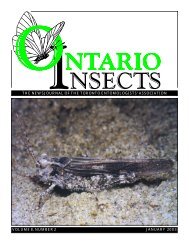1995 - Toronto Entomologists' Association
1995 - Toronto Entomologists' Association
1995 - Toronto Entomologists' Association
You also want an ePaper? Increase the reach of your titles
YUMPU automatically turns print PDFs into web optimized ePapers that Google loves.
Ontario InsectsThe NeLcontinued from previous pageBUGNET: has been formed to meet theneed for a "non-professional" entomologymailing list, Le. to serve as a resourcefor teachers and bug enthusiaststo ask questions to professional entomologists.To subscribe, send an emailmessage to listproc@listproc.wsu.eduwith a blank subject line and body textconsisting of SUBSCRIBE BUGNET JOHN DOEwhere John Doe is your real name. Formessages to the subscribers, send tobugnet@listproc.wsu.edu.DPLEX-L: is for use by teachers, researchers,students and others interested in theMonarch Watch and/or monarch biology.Contact Julie Ellis at jellis@kuhub.cc.ukans.edu for more information.ENTNET: is maintained by the EntomologicalSociety of America, and automaticallyprovides weekly updates of the up-coming ESA Annual Meeting, completetexts of the table of contents of ESAjournalsthat won't be published until threemonths later, listings of articles tentativelyscheduled for journals that willnot be printed for another five or sixmonths, weekly electronic versions ofthe ESA Newsletter, and more. To subscribe,send a message to listmgr@entsoc.org with the single line SUBSCRIBE ENTNET YOUR-REAL-NAME YOUR-EMAILADDRESS.ENTOMO-L: is maintained at the Universityof Guelph in Canada, and pertainsto entomology in general. To join thelist, send an e-mail message with a blanksubject line to listserv@uoguelph.cawith the text as follows: SUBSCRIBEENTOMO-L YOUR-NAME (where your-nameis your real name). You will then receiveregular messages on entomological topics(usually about 5-10 per day) fromother members in the group.MOSQUITO-L: is for the discussion of topicsrelated to mosquitoes (Diptera:Culicidae). Send an e-mail message tomosquito-I-request@iastate.edu with theword SUBSCRIBE in the body of the message(subject field will be ignored). Ifyour e-mail program automatically addsyour signature to the end of your message,put the word END on a separateline after the word subscribe. Once youare subscribed to Mosquito-L, sendinga message to mosquito-l@iastate.eduwill send your message to all the subscribers.If you prefer a digest version,send a message to mosquito-I-digestrequest@iastate.eduin lieu of the above.The list is maintained by John VanDykUvandyk@iastate.edu) at Iowa StateUniversity.MOTH@GYPSY: is a listserver that is dedicatedto exchange of information aboutthe gypsy moth world-wide. You cancontinued on page 19...More Trips...continued from page 13McGaw): Sharp-lined Yellow (Sicymacularia); Chickweed Geometer(Haematopsis grataria); Large Lace-border(Scapula limboundata); GrapeLeaffolder (Desmia funeralis).~Field TripBranchton, July 23,<strong>1995</strong>Bill EdmondsWe woke up Sunday morning to pouringrain in <strong>Toronto</strong>. We quickly turnedon the weather channel to try to determinewhat the weather was like in Cambridge.Rain and thunderstorms wereforecast. What should we do? Thosewho were coming that day started tophone us to find out if the trip was onor not. We hemmed and hawed and thendecided to go on with the trip but tochange the starting time to 11 :30 insteadof our intended 9:30. When we left14<strong>Toronto</strong> it was raining, butas we nearedCambridge the rain stopped. By the timewe all met at Tim Horton's, it seemedthat the rain was gone, and by 4 pm thesky was a perfect blue.There were 9 of us -- Nancy and myself,Paul McGaw, Caroline King,Quimby Hess, Jim Spottiswood, JohnPrideaux, Chris Rickard, and CharlesHeller. We saw 34 species between 12and 5 (much less than the 44 speciesthat we saw last year), but the seasonhad been a bit odd. Branchton is an oldrailway line. The ties were removedsome years ago, and the pathway leftgoes through some different habitats,though not much forest. There are a fewpatches of boggy area that are home tomany species, including the sedge skippers.Paul and Caroline pursued themoths and identified 10 of them. Thefollowing is a list of what we saw:Alfalfa Sulphur (4); Cabbage Whites (10);Mustard White (6); Pearl Crescent (10);Question Mark (1); Great Spangled Fritillary(9); Bronze Copper (1); AcadianHairstreak (11 including 2 mating pairs);Coral Hairstreak (1); Banded Hairstreak(3); Striped Hairstreak (1); BroadwingSkipper (37); Black Dash (21); NorthernBroken Dash (1); Tawny Edged Skipper(2); Crossline Skipper (1); Silver SpottedSkipper (1); Peck's Skipper (1); Dun Skipper(3);Delaware Skipper (8); EuropeanSkipper (1); Dion Skipper (1 female);Common Sooty Wing (1); NorthernPearly Eye (2); Wood Nymph (4); EyedBrown (10 including one mating pair);Spring Azure (4); Eastern Tailed Blue (4);Viceroy (2); Monarch (5); AmericanPainted Lady (1); Baltimore (4); EasternBlack Swallowtail (3 + 1 larva on wildcarrot); Tiger Swallowtail (2)~Hummingbird Clearwing; ForageLooper; Large Lace Border; EuropeanCorn Borer; Slant lined Owlet; ConfusedEusarca; Helvibotys helvialis; CeleryLooper; Reversed Haploa; GrapeLeaffolder moth (Desmia funeralis)Michael van der PoortenSeptember, <strong>1995</strong>



